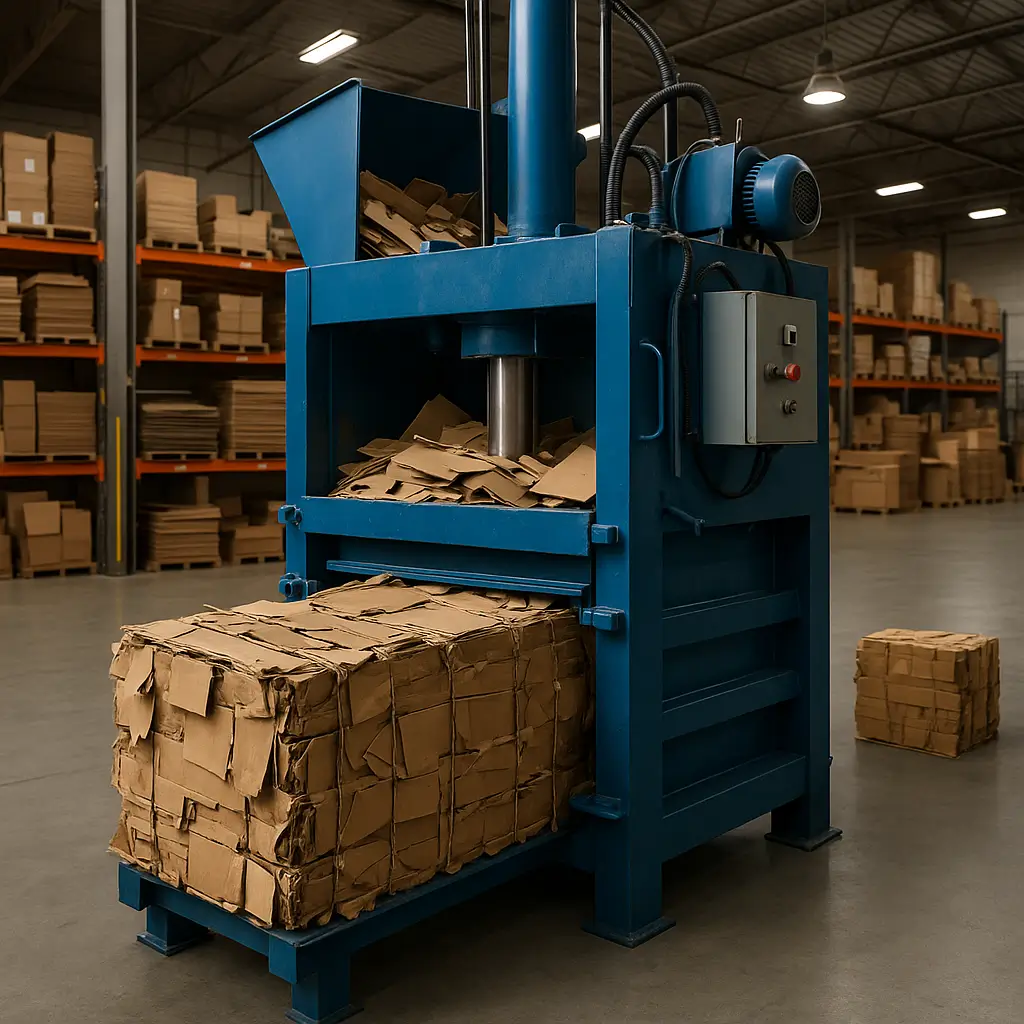Key Takeaway: Investing in a cardboard baler transforms loose, bulky cardboard waste into compact, manageable bales—reducing storage costs by up to 80%, streamlining recycling processes, and supporting sustainable waste management practices.
1. What Is a Cardboard Baler?
A cardboard baler is an industrial machine designed to compress cardboard waste into dense, uniform bales bound with wire or strapping. These devices vary in size from small, manual models suitable for retail back rooms to large, fully automatic systems used in distribution centers and manufacturing plants. By applying significant hydraulic pressure, cardboard balers reduce the volume of cardboard by up to 90%, turning loose sheets and boxes into tightly packed bundles ready for recycling or disposal.
2. Why Use a Cardboard Baler?
Businesses generate cardboard waste daily—from shipping boxes to product packaging—and storing loose cardboard quickly consumes valuable floor space. A cardboard baler addresses multiple operational and environmental challenges:
- Space Optimization: Compact bales occupy far less room than loose cardboard, freeing up storage areas for inventory or customer space.
- Labor Efficiency: Baling reduces the number of required waste pick-ups. Instead of handling dozens of loose-carton loads, employees manage just a few heavy bales.
- Transport Cost Savings: Waste haulers typically charge by volume. Denser bales cut hauling frequency and associated fees, leading to annual savings of thousands of dollars.
- Environmental Impact: Cardboard balers facilitate recycling by producing standardized bales that recycling facilities accept readily. This supports corporate sustainability goals and reduces landfill contributions.
- Regulatory Compliance: Many municipalities enforce strict recycling mandates. Baling cardboard on-site simplifies compliance with local regulations and reporting requirements.
3. How Does a Cardboard Baler Work?
A cardboard baler utilizes a combination of mechanical design and hydraulic power to perform four core actions:
- Loading: Loose cardboard is fed into the top-loading chamber (in vertical balers) or onto a conveyor belt (in horizontal balers). Operators break down boxes and load material evenly to ensure optimal compaction.
- Compression: The hydraulic ram activates, exerting thousands of pounds of force to compress the cardboard vertically (or horizontally). Pressure gauges and automatic shut-off valves prevent overloading.
- Tying/Strapping: Once compressed to the predetermined size—often adjustable between 30 inches and 48 inches in height—a built-in mechanism or manual access door allows operators to wrap galvanized steel wire or heavy-duty strapping around the bale. Automated balers feature integrated tiering systems that cycle through strapping and cutting.
- Ejection: After binding, the machine retracts the ram and opens the chamber door. The finished bale slides out onto the floor (vertical balers) or is discharged via an ejector plate onto a receiving area or conveyor (horizontal balers).
Key components include:
- Hydraulic Pump and Ram: Generate compressive force.
- Control Panel: Offers start/stop, emergency stop, and bale-size settings.
- Feed Chamber: Receives the material to be baled.
- Tie-off Ports or Automatic Tiering: Secure the compressed bale.
- Safety Guards and Sensors: Protect operators and prevent accidental activation.
4. Applications and Uses
Cardboard balers serve a wide range of sectors:
- Retail Stores: Grocery chains, department stores, and big‐box retailers bale incoming packaging on a daily basis to maintain front‐of‐house aesthetics and back‐of‐house efficiency.
- Warehouses and Distribution Centers: High volumes of incoming and outbound cardboard make balers essential for uninterrupted operations.
- Manufacturing Plants: Production lines generate cardboard waste from raw‐material shipments; balers convert this into revenue through recycling rebates.
- Printing and Publishing: Paperboard off‐cuts and shipping cartons are baled for recycling.
- Municipal Recycling Facilities: Centralized programs use large balers to process residential or commercial cardboard collections.
Beyond mere waste reduction, baled cardboard can also be:
- Sold to recycling brokers for additional revenue.
- Donated or exchanged with local farms for livestock bedding.
- Processed on-site by corrugators turning it back into paper products.
5. What Does a Cardboard Baler Look Like?
Visually, cardboard balers fall into two primary categories:
- Vertical Balers:
- Footprint: Compact (often under 5 feet wide).
- Height: Between 6 and 9 feet tall.
- Operation: Operators stand at the front to feed loose cardboard.
- Bale Ejection: Manual or automated plate pushes bale onto floor.
- Ideal For: Smaller volumes and limited floor space.
- Horizontal Balers:
- Footprint: Larger (10–20 feet long) with conveyors.
- Bale Size: Produce wider, longer bales (e.g., 60 inches × 30 inches).
- Operation: Material loaded via conveyor or skid loader.
- Bale Ejection: Electronic ram and ejector plate discharge bales automatically.
- Ideal For: High‐volume operations that demand continuous baling.
Color schemes often include industrial yellow, green, or blue. Safety decals, control boxes, and hydraulic lines are prominent features. Sound levels during operation can reach 85 dB, so hearing protection may be required.
6. Why Would I Need a Cardboard Baler?
Choosing to invest in a cardboard baler hinges on specific business metrics:
- Monthly Cardboard Volume: Operations generating more than 1,000 pounds of cardboard waste monthly typically recover the baler’s cost within 12–18 months through decreased hauling fees alone.
- Space Constraints: Facilities seeking to reclaim 200–500 square feet of storage or back‐of‐house area find balers immediately impactful.
- Sustainability Goals: Companies targeting zero waste or LEED certification benefit from streamlined recycling processes and documented bale weights.
- Labor Optimization: Reducing manual handling by up to 60% improves worker safety and reallocates staff to revenue‐generating tasks.
- Return on Investment: New vertical balers range from $5,000 to $15,000; horizontal models cost $20,000 to $60,000. With recycling rebates and hauling savings, most users see a payback period under two years.
7. Considerations When Selecting a Cardboard Baler
When evaluating baler options, compare these factors:
- Bale Weight Capacity: Choose a model that produces bale weights aligning with hauling minimums (typically 500–1,200 lb).
- Throughput Rate: Measured in pounds per hour; higher in horizontal balers (up to 8,000 lb/hour).
- Automation Level: Manual, semi‐automatic, or fully automatic tiering and ejection.
- Footprint and Layout: Ensure clearance for loading, maintenance, and ejection.
- Power Requirements: Most require 220 V three-phase power; confirm onsite electrical capacity.
- Safety Features: Lockout/tagout, interlock doors, emergency stops, and warning lights.
- Warranty and Service: Access to local technicians and replacement parts for minimal downtime.
8. Operational Best Practices
To maximize equipment lifespan and efficiency:
- Train Operators Thoroughly: Emphasize safety protocols and correct loading patterns.
- Maintain Hydraulic Systems: Regularly check fluid levels and inspect hoses for leaks.
- Schedule Routine Inspections: Clean shear blades, verify tie‐off mechanisms, and test sensors.
- Implement Recycling Policies: Break down cartons fully, remove non‐cardboard contaminants, and consolidate baling schedules.
- Track Bale Metrics: Record bale counts, weights, and service logs to identify trends and optimize usage.
9. Environmental and Economic Impact
By converting loose cardboard into manageable bales, businesses contribute to a circular economy:
- Reduced Greenhouse Gas Emissions: Compact transportation reduces truck miles and diesel consumption.
- Resource Conservation: Recycling one ton of cardboard saves 46 gallons of oil and 31 mature trees.
- Cost Avoidance: Lower landfill tipping fees and improved operational efficiency translate into significant annual savings.
- Corporate Responsibility: Demonstrating proactive waste management enhances brand reputation and meets stakeholder expectations.
Conclusion
A cardboard baler is more than a waste‐management tool—it is an investment in operational efficiency, environmental stewardship, and cost reduction. By compacting cardboard into dense, uniform bales, businesses reclaim valuable space, minimize labor and hauling expenses, and support sustainability goals. Whether for a small retail outlet or a large manufacturing facility, selecting the right baler—and adhering to safe, effective baling practices—yields measurable benefits that far exceed the initial purchase price.



Leave a Reply